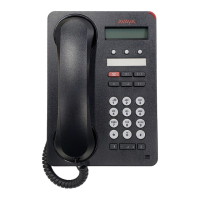Administration Overview and Requirements
12 Avaya 1603SW-I SIP Deskphones Administrator Guide
The conditions under which the 1603SW-I SIP IP Deskphones need to operate are summarized
as follows:
● Telephone Administration on the Communication Manager (CM) call server, as covered in
Chapter 4: Avaya Aura Communication Manager Administration
.
● Administration on Avaya Session Manager (SM), as covered in Administering Avaya
Aura™ Session Manager (Document Number 03-603324), or administration on Avaya
SES, as covered in Session Manager (SM) and SIP Enablement Services (SES)
Administration.
● IP Address management for the telephone, as covered in Chapter 6: Server
Administration for dynamic addressing. For static addressing, see the Avaya one-X™
Deskphone Value Edition SIP for 1603SW-I IP Deskphones Installation and Maintenance
Guide.
● Tagging Control and VLAN administration for the telephone, if appropriate, as covered in
Chapter 8: Administering Telephone Options
.
● Quality of Service (QoS) administration for the telephone, if appropriate. QoS is covered in
QoS
on page 25 and QoS on page 34.
● Protocol administration, for example, Simple Network Management Control (SNMP) and
Link Layer Discovery Protocol (LLDP).
● Interface administration for the telephone, as appropriate. Administer the telephone to
LAN interface using the PHY1 parameter described in Chapter 3: Network Requirements
.
Administer the telephone to PC interface using the PHY2 parameter described in
“Interface Control” in the Avaya one-X™ Deskphone Value Edition SIP for 1603SW-I IP
Deskphones Installation and Maintenance Guide.
● Application-specific telephone administration, if appropriate, as described in Chapter
8: Administering Telephone Options. An example of application-specific data is specifying
the extent to which users can add/edit/delete data for Contacts entries.
Table 1
indicates that you can administer system configuration parameters in a variety of ways
and use the following administrative mechanisms:
● Administering the information on the call server.
● Manually entering the information by means of the telephone dialpad using local
administrative (Craft) procedures. Local administrative procedures are described in
“Chapter 3: Local Administrative Options” in the Avaya one-X™ Deskphone Value Edition
SIP for 1603SW-I IP Deskphones Installation and Maintenance Guide.
● Administering the DHCP server.
● Editing the configuration file on the applicable HTTP or HTTPS file server.
● User modification of certain parameters, when given administrative permission to do so.
Note:
Note: Not all parameters can be administered on all administrative mechanisms. See
the applicable chapters in this guide for specific information.

